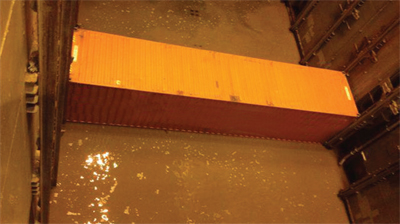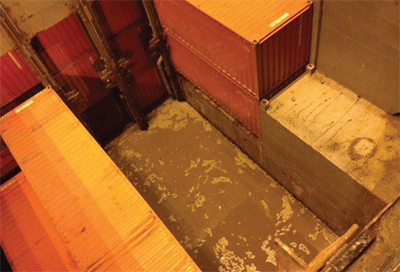Wet Damage to Containers, Manholes and Bilges
 |
 |
The Club has experienced a number of wet damage claims on container vessels recently and in this article we will examine some common causes of this and look at ways to reduce the risk of similar claims occurring.
There are many ways in which water could enter the cargo hold of a container vessel. Ballast tanks can be damaged, water can enter the hold via manhole covers, via the bilge system or through the hatch covers. In recent cases we have seen particular problems with manhole covers and water entering the holds via the bilge system.
Obviously water (or indeed oil) ingress fromtanks, or via the bilge system, presents a considerable risk as the entire bottom tier of cargo may be damaged. On some of the latest ultra large container vessels this means that perhaps as many as 80 – 100 containers may be affected in one hold, depending on the design of the vessel. Obviously this type of incident can lead to very costly claims.
Often these claims occur due to routine procedures being overlooked by ships’ staff and it is important that company procedures in relation to bilge wells and manhole covers are followed.
Bilges
Bilge related claims occur for a number of reasons. Common causes of incidents are outlined below along with some suggestions for risk reduction:
- Heavy rain fall in port – prudent bilge water management on board vessel including regular use of oily water separator when applicable and viable, ensuring that bilge holding tank has enough remaining capacity for cargo hold bilge wells during potential heavy rain in port.
- Failure of bilge well alarms – regular physical testing of cargo hold bilge well float alarms will ensure that an alarm will be activated once the bilge well is full. As long as the alarm is acted on quickly then the water level in the cargo hold should not rise above the level of the bottom of the containers.
- Non-return valve failure – planned maintenance of bilge and emergency ballast system to be followed closely and procedures to be in place to ensure that all tests are carried out effectively, as wellas checking of non-return valves and their correct fitting and function.
- Bilge strainers and valves blocked by debris – a good standard of housekeeping including cleaning of cargo holds to prevent dirt ingress into hold bilge strainers.
Manhole Covers
Manhole cover related claims occur for a number of reasons. Suggestions for risk reduction are outlined below:
- Regular inspections of manhole covers in cargo holds for fuel and ballast tanks as well as ensuring that manhole cover nuts are regularly checked for tightness. Gaskets to be replaced when necessary.
- Manhole covers to be checked by crew after shore side tank repairs. The same crew member to witness removal and fitting of covers to reduce the chance of errors. Any system should involve final checks by a responsible officer to ensure the manhole is correctly fitted. A similar system should be in place for on board work being carried out by the crew.
- Manhole cover locations to be checked on plans to ensure correct manhole cover is opened/ closed. This operation should be supervised by a responsible officer.
Obviously there are other causes of ingress and proper maintenance and inspection of atch covers and tank tops is necessary to protect cargo from ingress. None of the suggestions above are new and the vessel you are sailing on is likely to have procedures in place dealing with these matters. Make sure you are aware of and follow the procedures.

 , you have now set your site language to English. If you'd like to change your language preference again, simply click on one of the other flags.
, you have now set your site language to English. If you'd like to change your language preference again, simply click on one of the other flags. を選択して頂くと、言語設定が日本語に切り替わります。設定変更後は以下の機能が利用可能です。
を選択して頂くと、言語設定が日本語に切り替わります。設定変更後は以下の機能が利用可能です。
 ,可将网站语言设置为中文。这能帮助您:
,可将网站语言设置为中文。这能帮助您:


